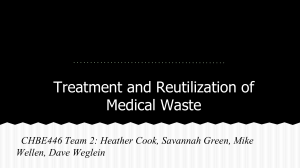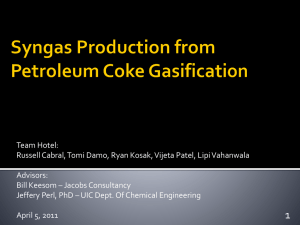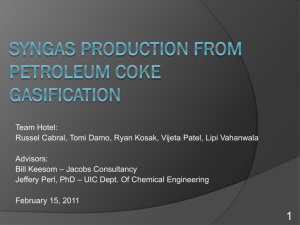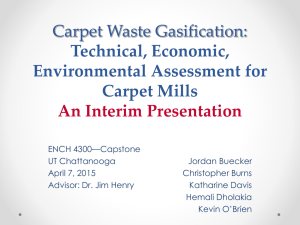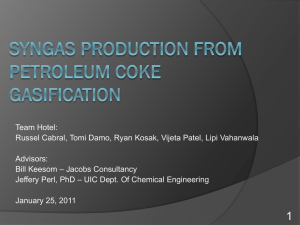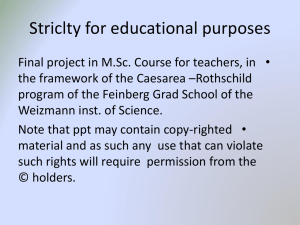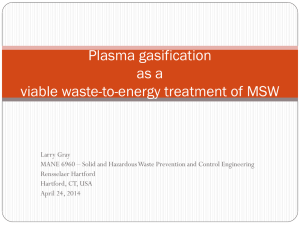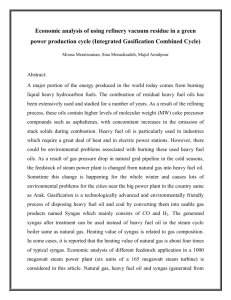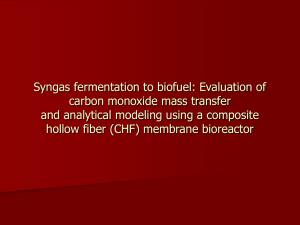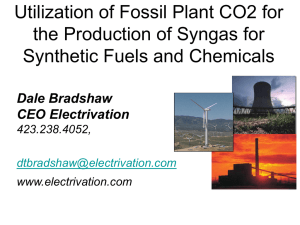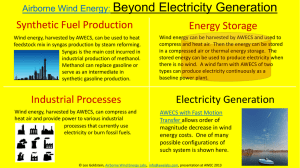Senior Design Report v1.1
advertisement
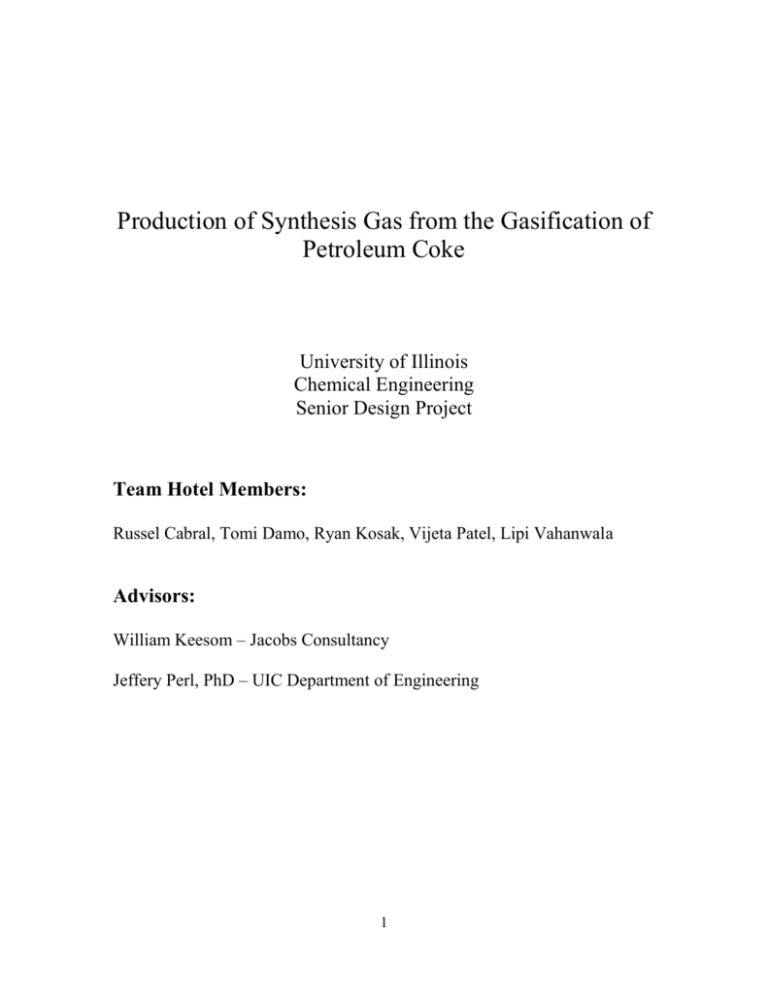
Production of Synthesis Gas from the Gasification of Petroleum Coke University of Illinois Chemical Engineering Senior Design Project Team Hotel Members: Russel Cabral, Tomi Damo, Ryan Kosak, Vijeta Patel, Lipi Vahanwala Advisors: William Keesom – Jacobs Consultancy Jeffery Perl, PhD – UIC Department of Engineering 1 Table of Contents Abstract.............................................................................................................................4 1. Introduction 1.1 Petroleum Coke Background 1.2 Gasification Technology Background 1.3 Research Review 2. Petroleum Coke Gasification Process 2.1 Process Overview 2.2 Petroleum Coke Feed 2.3 Petroleum Coke Gasifier 2.4 Water-Gas Shift Reactor 2.5 Sulfur Removal Process 2.6 CO2 Sequestration 2.7 Heat Recovery Utilization 3. Aspen Plus Process Simulation 3.1 Simulating the Petroleum Coke Feed Stream 3.2 Simulating the Gasifier 3.3 Simulating the Water-Gas Shift Reactor 3.4 Simulating the Sour Gas Cleanup Blocks 3.5 Simulating the CO2 Capturing 3.6 Simulating the Heat Exchanger Blocks 3.7 Simulating the Separator and Filter Blocks 3.8 Simulating the Compressors and Pumps 3.9 Simulation Results 4. Equipment Sizing and Costing 4.1 4.2 4.3 4.4 4.5 4.6 Main Units 4.1.1 Coke Grinder 4.1.2 Gasifier 4.1.3 Water-Gas Shift Reactor 4.1.4 Sulfur and CO2 Removal Heat Exchangers Separators and Filters Compressors and Pumps Feed and Utility Streams Total Capital Investment Summary 2 5. Economics 5.1 5.2 5.3 Annual Operating Costs Future Outlook and Operation Cost Summary 6. Environmental Review 6.1 6.2 6.3 6.4 6.5 Petroleum Coke Impact Gasification Impact Process Output Streams Impact Environmental Quality Regulations Environmental Summary References Appendix A. Sample Material Balance Appendix B. Sample Energy Balance Appendix C. Simulation Sensitivity Analysis Appendix D. Simulation Blocks and Streams Results Appendix E. Sample Costing Calculations 3 Abstract Proper utilization of raw natural materials is gaining importance now because of environmental impact and a lack of future availability. Crude oil is a prime example, proper utilization means harnessing the maximum potential of all crude oil byproducts. Petroleum coke is a major byproduct that has gone under utilized in the past. The primary goal of this project is to show the utilization of petroleum coke with gasification technology to produce synthesis gas, syngas, to be used in future chemical productions. Petroleum coke feed into an entrained bed gasifier along with steam and oxygen to produces primarily carbon monoxide (CO), hydrogen (H2), carbon dioxide (CO2), hydrogen sulfide (H2S) and methane. The syngas will be cleaned of solids by removing the ash with cyclone and filter technologies. The H2S will be converted into sulfur dioxide (SO2) and then into elemental sulfur through the Claus process. Then the CO2 will be removed and piped into a gulf coast oil reservoir. The remaining clean syngas will go to a water gas shift reactor to properly adjust the desired ratio of CO: H2. The prepared syngas will then be piped to a chemical plant to produce acetic acid. 4 1.2 Gasification Technology Figure 1: Shell Gasifier System (Higman, Burgt 119) The ground, pressurized coke is transported along with Nitrogen gas (Because Nitrogen is an inert gas). This petcoke is supplied with 95% Oxygen and steam through nozzle of the burner on the wall. The temperature inside the reactor is about 2700 ⁰F and pressure is around 350-600 psi which speeds up the reaction. As a result, the syngas leaves the reactor from the top through the lock hopper .The steam that is left behind, leaves the reactor through the annular space at medium pressure. The slag comes down in the reactor where it is quenched in a water bath. The Boiler Feed Water (BFW) supplied to annular wall of the gasifier is used as water bath. The huge temperature drop due to water bath results into hardening of the slag. This slag is ground by slag crusher. The granulated slag leaves the reactor through the lock hopper and the Boiler Feed Water (BFW) supplied to cool the slag, moves to heat exchanger. The BFW water is supplied that liquefies the slag. 5 The syn gas goes into the heat exchanger where it’s cooled by supplied Boiler Feed Water (BFW). As a result, syn gas moves down the heat exchanger and water leaves the heat exchanger as High Pressure Steam. Additional Boiler Feed Water (BFW) is supplied from the bottom nozzle of the heat exchanger that cools the syn gas even more. This water comes out of the heat exchanger as medium pressure and the syn gas leaves the heat exchanger at approximately 536⁰F and passes a candle filter unit where the solids from the gas are removed. About half the gas is then recycled via recycle gas compressor as quench gas and the other half is cooled in water scrubbing system. Syngas Quench (Maurstad 26) At the outlet of the gasifier reactor the temperature of the syngas is around 1500°C and the fly ash (or slag) is in liquid form. To protect downstream process equipment from fouling, a quench is needed to solidify the slag and make it non-sticky. Water Quench A water quench uses sensible heat from the syngas to vaporize water. The quench may be total as in the simplest version of the GE gasifier where the syngas is saturated with water vapor, or it may be partial where the syngas is only cooled down to around 900°C. In the latter case, heat recovery by production of HP steam would be included. In both cases, the addition of water drives the water gas shift reaction to increase the H2/CO ratio which is beneficial in the case of CO2 capture. 6 Radiant Syngas Cooler The radiant syngas cooler is available in one version of the GE gasifier. The hot gas flows into a radiant boiler where saturated steam is generated. At the Tampa IGCC demonstration plant, problems with the seals protecting the cooler shell from hot syngas caused five forced outages from 1997 to 2001, but the operators felt a solution was close Quenching by Recycle Quenching by recycle of cooled syngas is applied in the Shell gasifier. After particle removal in the candle filter, about half of the syngas flow which has a temperature around 300°C is recompressed and recycled to the gasifier outlet. By mixing the 1500°C hot syngas with the recycle stream, a cooling down to around 900°C is achieved. Heat is then recovered in a convective syngas cooler. N/A Chemical Quench Chemical quench is a concept which has less experience, but offers some interesting advantages. The principle is the addition of a second gasification step which uses the sensible heat in the hot syngas, and not oxygen, to gasify the coal feed with water. This ensures that the second stage is nonslagging (slag is solid). Because the outlet gas temperature is decreased and has less sensible heat, the cold gas efficiency is increased. A disadvantage is that some tars, which make gas cleanup more complex, may be formed. Conoco Philips’s slurry feed gasifier (E-gas) incorporates this principle. 7 N/A Reference: Higman, Chris, and Maarten Van Der. Burgt. Gasification. Amsterdam: Gulf Professional Pub./Elsevier Science, 2008. Print. Maurstad, Ola. An Overview of Coal Based Integrated Gasification Combined Cycle (IGCC) Technology. Rep. Cambridge: Massachusetts Institute of Technology, 2005. For Energy and Environment. Scribd. Web. 2 Feb. 2011. <http://www.scribd.com/doc/35269273/24/Syngas-quenching>. 8 2.4 Water Gas Shift Reactors A water as shift reaction is a reversible exothermic reaction where the reactants are carbon monoxide and steam and the desired products are hydrogen gas and carbon dioxide. The reaction is show below. COH2O CO2 H2 (-39.01BTU/mol) The reason this reaction process is necessary in the process is because the syngas must be at a 2: 1 molar ratio of H2: CO. The feed stock petcoke has a large carbon content and therefore mainly produces CO and CO2 with very little H2 being produced in comparison. Since such a large amount of CO is produced the syngas stream will be split and one part will remain with its high concentration of CO while the other is feed into water gas shift reactors to convert the CO to H2. The two streams will be combined in order to produce the desired molar ratio. The kinetic of the reaction are important in order to determine the amount of desired products produced. The two main variables in the kinetic are temperature and pressure. The pressure does not affect the reaction significantly since both sides contain the same moles of gas. The equilibrium constant (products over reactants) is highly affected by temperature and can be shown by the graph below. 9 Figure XX. Shows equilibrium relation to temperature (# reference) The equilibrium constant is also calculated with the empirical equation shown below. The graph and equations show a favorable leaning toward low temperature reaction settings. Water gas shifts are typically conducted in two stages an initial high temperature shift (HTS) then followed by a low temperature shift (LTS). Both of these reactors contain a certain amount of catalyst in relation to the feed amount. There are a variety of catalyst technologies that cater to specific shifting requirements. The following are a few of the catalyst bases available, Ferrochrome, Copper-Zinc and Cobalt – Molybdenum. 10 2.5 Sulfur Removal Process In most cases the gas must be cooled to atmospheric, with the exception of the desulfurization which may have ways of being performed at higher temperatures. The four main processes involved in gas clean up are: • Absorption (physical or chemical) in a liquid solvent with a subsequent desorption step. • Adsorption (again physical or chemical) onto a mass of solid particles. • Diffusion through a permeable or semipermeable membrane. • Chemical conversion, generally on a catalyst, often as a preparatory step to one of the above three methods. (Higman, page 298) It is important to pick the proper processes to ensure that the cleanest syngas is produced at the end of all the cleaning. Most particulates in the dirty gas can be removed through physical processes. The most common ways of particulate removal is through candle filters or through a cyclone. In the case of our process we will have to recycle some of the fly ash back to the gasifier were it can then be further used to form the slag wall in the gasifier and also is sent back so it can then come out in the slag. After the large particles are removed the dirty syngas can then be sent further purification. In the absorption system the acid components are removed through the use of solvents and regenerating those solvents to remove the unwanted components so it then can be reused in the absorber. The main purpose here is to remove the H2S and CO2 from the dirty syngas. There are many solvents available for this application, plus there are multiple processes that are implemented to clean the acid gas. Amines are used as a chemical wash with water to clean the acid gases. 11 “The principle amines used for synthesis gas treatment are mono- and diethanolamine (MEA and DEA), methyldiethanolamine (MDEA), and di-isopropanolamine (DIPA), the latter particularly as a component of the Sulfinol solvent. Others amines used in natural gas applications, such as diglycolamine (DGA) or triethanolamine (TEA), have not been able to make any significant impact in syngas applications” (Higman, page 301). The selection of the amine can be based off of how selective it is with H2S and CO2, for example MDEA absorbs CO2 more slowly than H2S. A table comparing this can be found in the Gasification book by Higman on page 302 which is below as table 1. Properties of Amine Solvents Standard Inhibited DEA MEA MEA 61 105 MDEA 119 Molecular Weight CO2 partial <100 <100 pressure (bar) Gas Purity CO2 20-50 20-50 (ppmv) Solution Strength 10-20 30 25-35 30-50 (wt%) Solution Loading 0.25-0.45 0.4-0.8 0.8 (mol/mol) Energy Demand 210 140 (MJ/kmol CO2) Selective Notes: Table 1: Properties of Amine Solvents (Higman, page 302) There are also physical washes that can be used in the acid gas separations because they have a good solubility with CO2, H2S, and COS and work at lower operating temperatures where the viscosity is increased and can be adjusted to affect the overall solubility (Higman, page 303). A table of these physical solvent properties can be found in the Gasification book by Higman on page 304 which is shown below as table 2. 12 Chemical Formula Mol. Weight Boiling Point at 760 Torr Melting Point Viscosity Properties of Physical Solvents Methanol NMP CH3OH CH3N-(H2C)3 C=O Kg/kmol 32 99 64 202 °C °C cP -94 0.85 at -15°C 1.4 at -30°C 2.4 at -50°C 790 1090 -24.4 1.65 at 30°C 1.75 at 25°C 2.0 at 15°C 1.027 533 DMPEG CH3O(C2H4O)X CH3 178 to 442 213 to 467 -20 to -29 4.7 at 30°C 5.8 at 25°C 8.3 at 15°C 1.031 Kg/m3 Specific Mass kJ/m3 Heat of Evaporation kJ/kg.K 0.6 0.52 0.49 Specific Heat at 25°C (H2S:CO2) 1:9.5 1:13 1:9 Selectivity at working temperature Table 2: Properties of Physical Solvents (Higman, page 304) In the case of our system we will most likely have to use a mixture of the two, which is appropriately named physical-chemical washes. Shell has produced a process using this method with a special chemical called Sulfinol (Higman, page 307). The original Sulfinol mix consisted of DIPA (the chemical solvent) and Sulfolane (the physical solvent). There is also m-Sulfinol solvent that uses MDEA as its chemical component (Higman, page 307). M-Sulfinol is used for larger scale processes such as our own. Oxidative washes (aka liquid redox) are an alternative to the Claus plant to remove the H2S into elemental sulfur. However this process will only convert the H2S so therefore the COS must be converted upstream to H2S to obtain a better purity in the end. Below is the figure from form Gasification on page 308 which shows a basic process flow of the Lo-Cat process that converts the acid gas into elemental sulfur be being 13 absorbed on aqueous chelated iron. The ferric iron oxidizes the HS- ion to elemental sulfur. Further on down the process path a bed of zinc oxide and also copper oxide can be used to ensure the remaining gas is as sulfur free as possible. Figure 1: Lo-Cat Flowsheet (Higman, page 308) HS− + 2Fe+3 → S0 + 2Fe+2 + H+ 2Fe+2 +½O2(l) +H2O. → 2Fe+3 + 2 OH− The Claus process is another method in removing the sulfur content from the syngas. The H2S is combusted with SO2 and water in the first stage at 1000-1200°C (1832-2192°F) where then the in the low-temperature second stage the SO2 is reacted with the remaining H2S to form sulfur (Higman, page 319-320). 14 Figure 2: Claus Unit (Higman, page 319) H2S + 1½ O2 ←→ SO2 +H2O 2 H2S +SO2 ←→ 2 H2O+ 3/8 S8 3 H2S + 1½ O2 ←→ 3 H2O+ 3/8 S8 In the second stage the gas is passed over and alumina catalyst at around 200-300°C (392-572°F) where is then sent to a cooler to condense the sulfur formed (Higman, page 319). This usually is performed two to three times, and in the case of our process it is most likely that we will perform this three times to ensure the most sulfur can be removed. 15 16
